Sex Criminals #2 ($2.99, Image)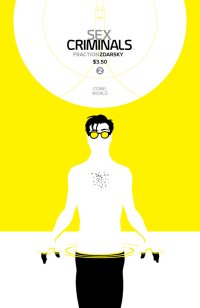
By D.S. Randlett (@dsrandlett)
Matt Fraction and Chip Zdarsky could stop here and Sex Criminals would be one of the year’s best series. In the first two issues of the series, Fraction’s script merely teases what could be considered overarching “A plot” of the series, the part that gives the series its name. In two issues, this story has only received about 4-6 pages of attention in favor of some arguably more important things like some rather luscious character building and an establishing a hilarious and punchy voice. Most importantly, these first two issues present a frank, honest, and humane examination of what can best be described as the American Heterosexual Experience.
Our own Jeb Delia covered the first issue (with much aplomb, I must say) a few weeks ago, so for now I think that it suffices to say that the first issue was an exploration of a young woman’s discovery and eventual mastery of her unique, to say the least, sexuality. It effectively captured the hero’s journey that is female sexual awakening in American culture, complete with different guardians (The Mother, The Older Girls), and crises of identity (Madonna? Slut? Person?). It was the story of coming into your sexuality in a culture where your sexuality is a closely guarded secret. Fraction and Zdarsky, in taking up the story of the male half of their duo, present a very different journey.
What is it like becoming a sexual being in a world where the fact of your sexuality is taken for granted? That’s the key question that informs Jon’s story in this issue. In the first non-heist pages of this story, Jon is every bit the stereotypical horny teen. Except instead of getting the closely guarded secrets of the Older Girls in the school’s ladies’ room, Jon goes out into the world and blunders into skin mags and is thwarted by internet blockers. But while he is driven by a sense of allure and the knowledge that he is supposed to want sex, he has no idea what that actually is, how it (or he, for that matter) is supposed to feel. Of course, he does figure out masturbation, and thus discovers his ability to access “The Quiet,” as Suzie calls it. It’s worth noting here that Jon doesn’t so much discover his sexuality, which Suzie did, as much as he seemed to blunder into it. After all, his sexuality was expected. It was everywhere, and a hilarious key scene that takes place in a porno store, which is populated only by men, drives that point home.
Sex Criminals is hilarious, but more than that it is intelligent and honest. Much has been made of the fourth wall breaking in this title, but it serves the goals of the story much like the narration in Wong Kar Wai’s Chungking Express. Instead of feeling like a gimmick or an easy way to spin jokes, it serves as a means to let the book commiserate with the reader’s own experience. While the adults only tag certainly applies to the content on a surface level, it’s also an expression of intent on the part of Sex Criminals. This is a book for adults and what they feel, a book about memory and the parts of us that, once awakened, can never rest.
Rating: 




Out of a Possible 5 Stars
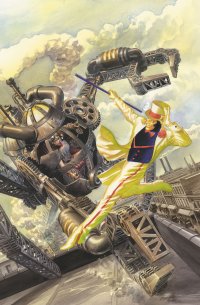 Astro City #5 (Vertigo, $3.99)
Astro City #5 (Vertigo, $3.99)By Adam Prosser
Welp. That wasn’t what I was expecting.
The solicits made this sound like the “Golden Age” issue of Astro City. And it is…and it isn’t.
For those of you who have somehow not had the pleasure of experiencing Kurt Busiek, Brent Eric Anderson and Alex Ross’s Astro City—and if so, man, are you in for a treat—part of the fun is the elaborate pre-existing world and backstory the three creators have developed for their comic, one that roughly parallels the real history of comics. However, most of the characters we’ve seen so far have been from the 50s and forward, and even then, only in a handful of issues. The Golden Age (and earlier) have been mostly a mysterious blank for this series, and I was eager to learn more.
The real subject of the book, though, is The Broken Man, the enigmatic character who reintroduced this latest series of Astro City and who seems to be at the heart of the ongoing storyline, with his jackdaw-like wall of stories connecting each other in a paranoid skein. The Broken Man seems to be a clever way of connecting conspiracy theories with metatextual storytelling, and he’s a convenient narrative device to boot, allowing Busiek’s script to bop back and forth between eras in a pattern we can’t discern yet.
That’s the thing: as Busiek himself admits in the afterward, this issue isn’t a story so much as it’s three fragments of other stories. One features a gang of G-men facing down a Lovecraftian horror in the 20s; another some kind of con man (or government agent?) duping a cargo cult of snake-worshippers in a remote kingdom; and a third sees the steampunk-y Dame Progress chasing a black cat burglar named Mr. Cakewalk (with some uncomfortable overtones of minstrelsy) around the turn of the century, when Astro City was still named Romeyn Falls. But the focus is on the Broken Man, who breaks in to interrupt and chastise us, the reader, for catching these glimpses; he’s still banging on about the Oubor, the mysterious evil force that apparently dwells in comic books and can reach out to grab you if you’re not careful. Shades of Alan Moore.
This is all a lot more experimental than I would have expected for this series, and I think that’s a very good thing. As rich and deep as the world of Astro City is, and as happily as I would continue to read about it for decades, there’s been a sense for a while now that Busiek and co. have said all they really need to say with this series, and the rest is just filling in the details. But since the Broken Man arc started, Astro City has felt weirdly refreshed, which was particularly needed after the extensive and somewhat exhausting “Dark Age” storyline. Rather than building to bigger and bigger crescendos, the series is suddenly moving sideways and reinventing itself for the modern era. Given how many times it’s seemed like Busiek was on the verge of abandoning this series altogether, it’s heartening to see it’s still capable of surprises.
Rating: 




Out of a Possible 5 Stars
Conan and the People of the Black Circle #1 of 4 (Dark Horse, $3.99)
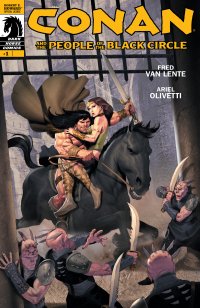
By Jeb D.
I doubt it gladdens the hearts of the Dark Horse marketing department, but one of the advantages to reading about licensed characters not burdened by decades of comic-book continuity is that it’s easy to drop in and out of the series as the mood strikes. I enjoyed the initial run of Dark Horse’s Conan: Kurt Busiek caught the right blend of the lurid and laconic in Howard’s writing, and Cary Nord managed to bring the Hyborian Age to rugged, Frazetta-cover life. But having done my Conan bit back in the day with the Thomas-Smith-Buscema runs, as well as the paperback collections, I haven’t really felt compelled to revisit the Cimmerian on any regular basis. I was intrigued by the prospects of this new miniseries, though,: not only does one not get painted interiors from Ariel Olivetti every day, but “People of the Black Circle” is one of Howard’s best stories: his “Afghulistan” is vivid and, in the context of a pulp adventure set in a fictional bronze age, well-researched. This story might also offer Howard’s best blend of might and mysticism: the use of magic here has an almost Lovecraftian sense of dread, rather than the usual simple movie-monster grotesques that populate many Conan adventures. Howard also provides an unusually strong supporting cast, including the well-realized Kerim Shah, with his doomed love for the handmaid Gitara; and while no one would ever mistake Howard for Joss Whedon, this story’s distressed damsel, the Devi Yasmina, is allowed to have agency that goes beyond her lust for the barbarian rogue who abducts her: she is prepared to submit to Conan in the bedroom, but only there: she rides at the head of her troops in the climactic battle, and parts from the Cimmerian on equal terms.
With all that, it’s disappointing to report that this miniseries represents a missed opportunity. Writer Fred Van Lente is a capable journeyman, able to show up and get the job done on Big 2 superheroes as well as this sort of licensed-character book. But I don’t think it’s coincidence that his sensibilities haven’t yet propelled him into the front ranks of today’s work-for-hire writers: there’s a bland flatness to the script, almost as though Van Lente were working from a Wikipedia summary of “People of the Black Circle,” rather than having immersed himself in the story itself. That’s clearly not the cast, though, as the script lathers huge chunks of Howard’s thick prose onto the page. There’s no question that, for all its virtues, “People of the Black Circle” is a rather talky Conan story, but Howard didn’t have the resource that Van Lente has here, in an artist like Olivetti: a pulp writer churning out this story in a few feverish days ahead of deadline might be excused for continually cramming background and exposition into paragraphs of narration and dialog, but so much of the mood and pace of the story that could be conveyed visually in a comic is subsumed to Van Lente’s evident desire to dutifully replicate Howard’s narrative choices, rather than explore visual ways to get at the guts of the story beneath. Howard probably understood the one picture/thousand words equation as well as anyone, but words were his only tool; a comic writer doesn’t have that excuse.
And while Olivetti’s art is expectedly skillful, it lacks the rough, and frankly “barbaric,” quality that Nord brought to the series’ original incarnation. Lines are clean and smooth, and his Afghulistan sparkles like something out of Disney’s Aladdin, with colors that verge on being too vivid. That’s a perfectly valid choice if an artist is working with a generic fantasy setting; but Howard’s prose places us in a darker, dirtier, more lived-in environment than we have here. The figure work is impeccable, faces distinct and well realized, paneling often creative, and I suspect that Olivetti will bring vigor and punch to the large-scale action scenes to come. There’s unquestionable artistry in this comic, and even some fun… there’s just not much in the way of the mood or magic that has kept Howard’s work indelible in the three-quarters of a century since his passing.
Rating: 




Out of a Possible 5 Stars
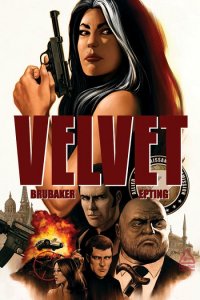 Velvet #1 (Image Comics, $3.50)
Velvet #1 (Image Comics, $3.50)By Devon Sanders
I’m sitting here writing this review of Velvet #1 and it really just comes down to, “I really liked it.”
That won’t do; this is a comics review, after all. I need to tell you why you should like it, too. Why you should plop down $3.50 and buy this comic.”
Because it’s really good? I don’t think that helps any.
OK, in writer Ed Brubaker and artist Steve Epting you get two of comics’ best telling a story well within their wheelhouse: espionage. As the creative team on Captain America, Brubaker and Epting took Captain America from his primarily superheroic roots and moved him into the world of global espionage, breathing new life and purpose into such long-standing characters as The Black Widow, The Falcon and most importantly, The Winter Soldier. All characters who will figure prominently in the upcoming Marvel flick named, you guessed it… Captain America: The Winter Soldier. Long story short, these are two people who know what they’re doing and what they do is tell great stories.
They’ve brought that same energy and more to their own new creator-owned work, Velvet, a tale of intrigue and betrayal set in the heart of The Cold War and the waning days of golden age of the super spy, 1973.
The world’s best spy is dead, leaving behind secrets and unfinished business. Men want those secrets as they live on through his personal assistant, Velvet Templeton, nearly 20 years removed from the field. Many thought they’d find an easy target in Velvet.
They were wrong. Dead wrong.
In Velvet Templeton, Brubaker gives comics a new strong, capable character you didn’t know you were waiting for. Velvet is uncomplicated in so many ways but is a character whose life is made complicated by the decisions of others. That’s where her biggest challenges come from and the true driving force behind this story. I’m definitely all in.
Epting is a phenomenal artist with a knack for knowing exactly what the story needs, be it quiet, confrontation or contempt. Epting does it all with a line that recalls the best work of the late John Buscema.
So, yeah… I really liked it I like great comics with great storytellers but then again, who doesn’t?
Rating: 




Out of a Possible 5 Stars
Marvel Now What?! 1-shot (Marvel, $3.99)
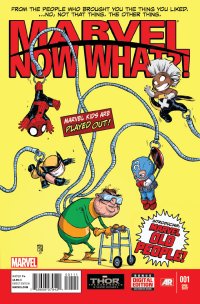
By Jeb D.
The last time Marvel tried one of these “we’re-so-cool-we-poke-fun-at-ourselves” anthologies, last fall’s Avengers vs X-Men wrapup, the Disney era was just hitting its stride, with the Avengers having stormed the box office and the comics division showing more commercial life than it had for some years; and the mixture of silliness and pointed commentary felt like the opening of possibilities. It was also one of the most visually varied comics of the series, with a clutch of top-tier artists and writers working on canvasses big and small (Mike Deodato’s contribution was simply one very funny splash page), from the semi-realistic to the outright cartoony. For better or worse, it was the best issue of that crossover.
What a difference a year can make. As incredible as it may seem, Marvel feels even more a corporate entity today than it ever has (and that’s saying something), and the constant drumbeat of epic/crossover/relaunch is bound to beget weariness, verging on ennui, in even the biggest fan of books like Hawkeye or Young Avengers (this is not to say that things aren’t as bad at DC; I just don’t happen to be reviewing one of their books here). In that light, it’s startling to encounter the tone of cynical snark that characterizes much of this humor collection: whereas a year ago, Dan Slott and Katie Cook could have a good-natured giggle about the inherent silliness of the crossover, this time writer Elliott Kalan has the High Evolutionary straightforwardly invoke the crass hyperbole of just how much “Now-er” things at Marvel can possibly get; artist Skottie Young cheerfully acknowledges the cash cow that his “Marvel Babies” cover work has been; and there’s scarcely any hint that anyone at the House of Mouse Ideas believes that today’s superhero comic is anything more than a promotional pamphlet for the next movie or Lego set.
Most of the writing comes this time not from industry pros, but from comedians like Kalan, and Wyatt Cenac, whose perspective is that of the well-informed, and oft-abused fanboy; it’s hard to know whether you should be laughing at the jokes, or crying at your own willingness to be part of the system that enables it all.
The other big difference between this comic and previous Marvel parodies is the occasional rigidity of the presentation. There’s some strong artists represented here (including Patrick Oliffe, Steve Lieber and Colleen Coover), but too often the verbose scripts force tight paneling with an overload of word balloons to get all the yuks in. Oliffe has some fun with a Doc Ock “origin” story, and Lieber brings a refreshing crudity to a Captain America story that works more on the level of actual humor than on-the-nose parody.
It’s tempting to pat Marvel on the back for being able to laugh at itself this way, but there’s a creepy sense that it’s not coming from reaction against the rampant commercialism that’s threatening to ossify the Marvel Universe (with the Star Wars universe up next): it’s coming from a media giant that is so impervious to satire, or criticism of any type, that it can basically throw its most obvious cash-grabs in our faces, let out a supervillain’s jeer, and dare us to do anything but pony up for the next round. Still, much of it’s pretty funny, I did laugh, and thanks to writers Sara Benincasa and John Devore, I’ve been able to annoy people all week by declaiming “Doom demands brunch!” On balance, then, more or less a win, even if I suspect it means I’ve been co-opted even more than I thought.
Rating: 




Out of a Possible 5 Stars
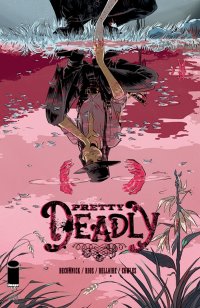 Pretty Deadly #1 (Image, $3.50)
Pretty Deadly #1 (Image, $3.50)
By Adam Prosser
I don’t know if this is something every kid goes through, but I strongly remember the discombobulation I felt when I discovered that the medieval era was something that actually happened. What I mean is that you grow up reading and listening to so many fairy tales about kings and queens, knights errant and princesses and castles and swordfights, all of it interspersed with wicked witches and dragons and ogres, and it’s a bit of a shock when you realize some of that stuff is real and some of it isn’t. Of course, even as an adult that whole epoch seems sort of hazy and fantastical, at least partly due to just how wild and uncivilized it was; this was a time when simply leaving your village was a bold undertaking that could get you horribly killed. Adventure just sort of suggests itself when you think about that time period.
For North Americans, there’s another era that carries some of the same barbaric glamour, and that’s frontier days, the Wild West. Never mind that, in reality, the archetypal lawless town with gunfights on every street corner was virtually unheard of; between pop culture and our awareness of this time as America’s Origin Story, as it were, when everything was being forged out of the raw materials of a virgin continent, the old west has always loomed in our imagination as a borderline mythic time when legends walked the earth. There’s something surreal about westerns at the best of times, and it doesn’t feel at all strange when one veers into fairy tale logic.
Which is basically exactly what Kelly Sue DeConnick and Emma Rios have done with Pretty Deadly, the new western comic from the lately-unstoppable Image Comics line. DeConnick starts the story with some timelessly mythic (and weird) figures, who tell a story that riffs directly on Rapunzel before taking a turn into blustering Tall Tale territory. Seems that (at least according to the tale we’re told) a Mason walled up his wife in a tower so he could have her all to himself; the woman prayed for death, but she was so beautiful that death himself fell in love, and she bore him a daughter before she passed. Death’s daughter, grown up and bearing facial marks that resemble a Mexican calavera, now hunts down the wicked and sinful across the haunted prairie.
DeConnick makes the interesting decision to make Deathface Ginny an entirely legendary figure in the context of the story, at least in this issue, appearing only in the story-within-a-story told by the main characters; even her appearance on the last page could be some kind of fever dream. This level of detachment helps create a character who seems like a legend in her own story, which is impressive given that the other characters include a blind shootist, a girl in a vulture cloak and a giantess bounty hunter. Rios’ energetic art, which has a strong Paul Pope feel, likewise creates a Lynchian mood.
While both script and art occasionally veer into chaotic territory—I’m not clear on who these guys who are shooting at Fox and Sissy one moment and riding alongside them the next are supposed to be—it’s an effectively hypnotic and compelling tale, suitable for reading round a campfire in any era.
Rating: 




Out of a Possible 5 Stars